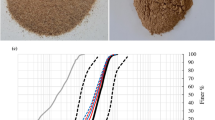Abstract
This work presents experimental observations of the characteristic fracture process of tempered glass. Square specimens with a side length of 300 mm, various thicknesses and a residual stress state characterized by photoelastic measurements were used. Fracture was initiated using a 2.5 mm diamond drill and the fragmentation process was captured using High-Speed digital cameras. From the images, the average speed of the fracture front propagation was determined within an accuracy of 1.0%. Two characteristic fragments were found to form on each side of the initiation point and are named “Whirl-fragments” referring to the way they are generated. An earlier estimation of the in-plane shape of the fracture front is corrected and a hypothesis on the development for the fracture front is offered. The hypothesis is supported by investigations of the fragments using a Scanning Electron Microscope (SEM) which also revealed a micro scale crack bridging effect.




















Similar content being viewed by others
References
Acloque P (1956) Influence of strain-systems in glass upon the course of its fracture. In: Proc. 4th. international congress on Glass Chaix, Paris, pp 95–106 (in French)
Acloque P (1962) High speed cinematographic study of the fracture process in toughened glass. In: Symposium on mechanical strength of glass and ways of improving it. pp 851–886 (in French)
Acloque P (1963) La fracture du verre propagation - influence des précontraintes. Verres Refract 17(3):151–162 (in French)
Acloque P (1975) Déformation et rupture des verres. Ann Mines 2:57–66 (in French)
Acloque P, Guillemet C (1963) The course of fracture propagation in glass under varying strain. In: Advances in Glass Technology—Part 2 (in French)
Adams L, Williamson E (1920) The annealing of glass. J Franklin Inst 190:597–632
Anton J, Aben H (2003) A compact scattered light polariscope for residual stress measurement in glass plates. In: Glass processing days
Barsom J (1968) Fracture of tempered glass. J Am Ceram Soc 51(2):75–78
Bartenev G (1948) The phenomenon of the hardening of glass. J Tech Phys 18:383–388 (in Russian)
Beason WL, Morgan JR (1984) Glass failure prediction model. J Struct Eng 110(2):197–212
Chaudhri MM, Liangyi C (1986) The catastrophic failure of thermally tempered glass caused by small-particle impact. Nature 320(6057):48–50
Cranz C, Schardin H (1929) Kinematographie auf ruhendem film und mit extrem hoher bildfrequenz. Z Phys 56(3–4):147–183 (in German)
Daudeville L, Carre H (1998) Thermal tempering simulation of glass plates: inner and edge residual stresses. J Therm Stress 21(6):667–689
Freund LB (1990) Dynamic fracture mechanics. Cambridge University Press, Cambridge
Gardon R (1980) Glass Science and technology 5: elasticity and strength in glasses, chap 5. Academic, London, pp 145–216
Griffith A (1920) The phenomena of rupture and flow in solids. Philos Trans R Soc Lond 221:163–198
Hull D (1999) Fractography—observing, measuring and interpreting fracture surface topography. Cambridge University Press, Cambridge
Inglis CE (1913) Stresses in a plate due to the presence of cracks and sharp corners. In: Proc. Inst. Naval Architects
Kerkhof F (1963) Maximale bruchgeschwindigkeit und spezifische oberflächenenergie. Die Naturwissenschaften 50(17):565–566 (in German)
Kurkjian C (1963) Relaxation of torsional stress in transformation range of soda-lime-silica glass. Phys Chem Glasses 4(4):128–136
Laufs W, Sedlacek G (1999) Stress distribution in thermally tempered glass panes near the edges, corners and holes: Part 2. Distribution of thermal stresses. Glass Sci Technol Glastech Ber 72(2):42–48
Lee E, Rogers T, Woo T (1965) Residual stresses in a glass plate cooled symmetrically from both surfaces. J Am Ceram Soc 48(9):480–487
Narayanaswamy O (1971) A model of structural relaxation in glass. J Am Ceram Soc 54(10):491–498
Narayanaswamy O (1978) Stress and structural relaxation in tempering glass. J Am Ceram Soc 61(3–4):146–152
Narayanaswamy O (2001) Evolution of glass tempering models. In: Glass processing days
Nielsen J, Olesen J, Stang H, Poulsen P (2007) An implementation of 3d viscoelastic behavior for glass during toughening. In: Glass performance days
Schwarzl F, Staverman A (1952) Time-temperature dependence of linear viscoelastic behavior. J Appl Phys 23(8):838–843
Soules T, Busbey R, Rekhson S, Markovsky A, Burke M (1987) Finite-element calculation of stresses in glass parts undergoing viscous relaxation. J Am Ceram Soc 70(2):90–95
Takahashi K (1999) Fast fracture in tempered glass. Key Eng Mater 166:9–18
Takahashi K, Aratani SI, Yamauchi Y (1992) Dynamic fracture in zone-tempered glasses observed by high-speed photoelastic colour photography. J Mater Sci Lett 11(1):15–17
Wallner H (1939) Linienstructuren an bruchflächen. Z Phys 114(5–6):368–378 (in German)
Wiederhorn S (1969) Fracture surface energy of glass. J Am Ceram Soc 52(2):99–105
Yoffe E (1951) The moving griffith crack. Philos Mag 42:739–750
Acknowledgements
The authors would like to thank Mads Bonde at ScanGlas (DK) for providing the glass specimens, The Villum Kann Rasmussen foundation for sponsoring the digital high-speed cameras, and Ebba Cederberg Schnell at DTU Byg for assisting with the SEM images.
Author information
Authors and Affiliations
Corresponding author
Rights and permissions
About this article
Cite this article
Nielsen, J.H., Olesen, J.F. & Stang, H. The Fracture Process of Tempered Soda-Lime-Silica Glass. Exp Mech 49, 855–870 (2009). https://doi.org/10.1007/s11340-008-9200-y
Received:
Accepted:
Published:
Issue Date:
DOI: https://doi.org/10.1007/s11340-008-9200-y




